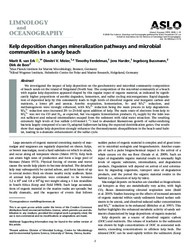Kelp deposition changes mineralization pathways and microbial communities in a sandy beach
Meier, Dimitri V.
Ferdelman, Timothy
Harder, Jens
Bussmann, Ingeborg
de Beer, Dirk
DOI: https://doi.org/10.1002/lno.11574
Persistent URL: http://resolver.sub.uni-goettingen.de/purl?gldocs-11858/9294
Persistent URL: http://resolver.sub.uni-goettingen.de/purl?gldocs-11858/9294
van Erk, Marit R.; Meier, Dimitri V.; Ferdelman, Timothy; Harder, Jens; Bussmann, Ingeborg; de Beer, Dirk, 2020: Kelp deposition changes mineralization pathways and microbial communities in a sandy beach. In: Limnology and Oceanography, DOI: 10.1002/lno.11574.
 |
Dokument öffnen: |
We investigated the impact of kelp deposition on the geochemistry and microbial community composition of beach sands on the island of Helgoland (North Sea). The composition of the microbial community at a beach with regular kelp deposition appeared shaped by this regular input of organic material, as indicated by significantly higher proportions of aerobic degraders, fermenters, and sulfur cycling microorganisms. Rapid degradation of deposited kelp by this community leads to high levels of dissolved organic and inorganic carbon and nutrients, a lower pH and anoxia. Aerobic respiration, fermentation, Fe- and SO42− reduction, and methanogenesis were strongly enhanced, with SO42− reduction being the main process in kelp degradation. SO42− reduction rates increased 20- to 25-fold upon addition of kelp. The main route of electrons from kelp to SO42− was not via CO and H2, as expected, but via organic fermentation products. O2 supply by the tides was not sufficient and reduced intermediates escaped from the sediment with tidal water retraction. The resulting extremely high levels of free sulfide (>10 mmol L−1) lead to abundant filamentous growth of sulfur-oxidizing bacteria largely composed of a rare O2-adapted Sulfurovum lacking the expected denitrification genes. Our results show that regular kelp deposition strongly enhances the thermodynamic disequilibrium in the beach sand habitat, leading to a dramatic enhancement of the sulfur cycle.
Statistik:
ZugriffsstatistikSammlung:
This is an open access article under the terms of the Creative Commons Attribution-NonCommercial-NoDerivs License, which permits use and distribution in any medium, provided the original work is properly cited, the use is non-commercial and no modifications or adaptations are made.

